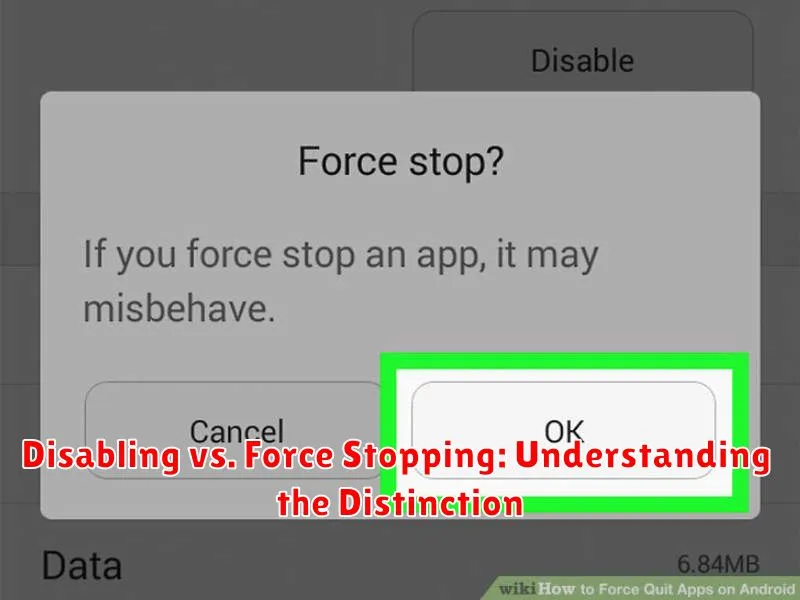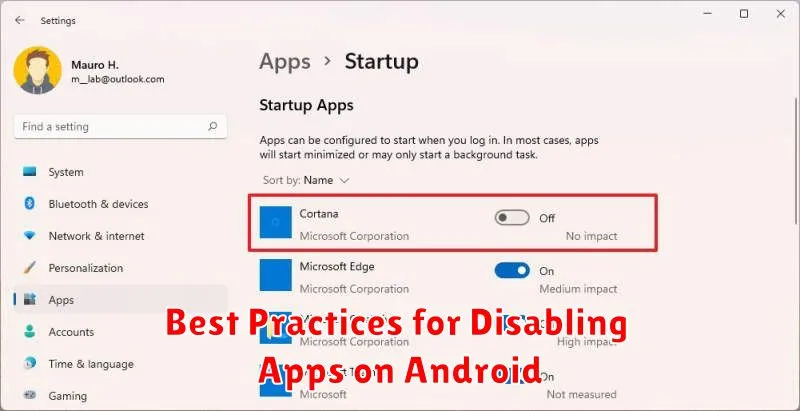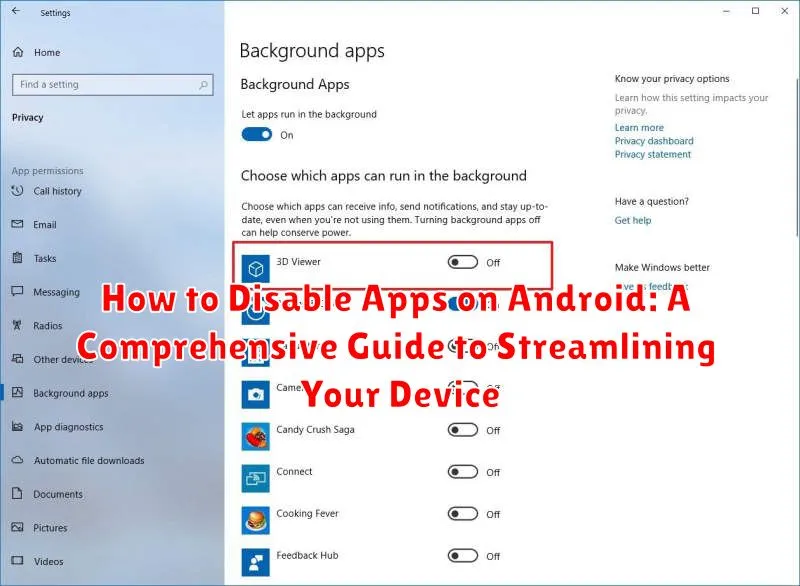In today’s digital age, our Android devices are often brimming with a plethora of applications. While many of these apps prove useful, an overabundance can lead to a cluttered interface, diminished battery life, excessive data usage, and potential security risks. This comprehensive guide will delve into the various methods available to effectively disable apps on your Android device, allowing you to streamline its performance and reclaim valuable resources. Learning how to disable apps on Android is a crucial skill for any user seeking to optimize their mobile experience. Whether you’re dealing with pre-installed bloatware, resource-intensive apps, or simply looking to declutter your app drawer, this guide will provide you with the knowledge and steps to achieve a cleaner, faster, and more efficient Android experience.
This article will cover several techniques, from the simplest built-in Android app disabling features to more advanced options for specific devices or situations. We will explore how to disable pre-installed apps, disable third-party apps, and even discuss the implications of disabling system apps. Understanding the differences between disabling and uninstalling apps is crucial, and we will clarify these distinctions. By the end of this guide, you will be equipped to expertly manage your Android apps, improving your device’s overall functionality and reclaiming control over your digital space. Join us as we unravel the complexities of disabling Android apps and empower you to tailor your device to your specific needs.
Why Disable Apps?
Disabling apps on your Android device offers several key benefits, ultimately contributing to a smoother and more efficient user experience. It’s a powerful tool for managing your device’s resources and optimizing performance.
Free Up Storage Space: While disabling an app doesn’t remove it completely, it does prevent it from consuming valuable storage space for updates and cached data. This is especially useful for pre-installed apps or large apps you rarely use.
Improve Performance: Disabled apps no longer run in the background, freeing up system resources like RAM and processing power. This can lead to noticeable improvements in overall device speed and responsiveness, particularly on devices with limited resources.
Extend Battery Life: Background processes consume battery power. By disabling unused apps, you prevent them from draining your battery, leading to longer usage time between charges.
Enhance Security and Privacy: Disabling apps can mitigate security risks by preventing potentially vulnerable or unwanted apps from accessing your data or running in the background. This is particularly important for apps with permissions you no longer want them to have.
Declutter Your Device: Disabling unused apps removes them from your app drawer, creating a cleaner and more organized interface. This makes it easier to find and use the apps you actually need.
Methods for Disabling Apps: Built-in Options, Third-Party Apps, and Developer Options
Android offers multiple avenues for disabling apps, catering to different user needs and technical comfort levels. The primary method leverages the built-in Settings app.
Built-in Settings
Navigate to Settings > Apps (or Apps & notifications depending on your Android version). Select the app you wish to disable, and if the option is available, tap Disable. This method is straightforward and suitable for most pre-installed and user-installed apps.
Third-Party Apps
Several third-party apps on the Google Play Store offer app management capabilities, including disabling multiple apps simultaneously. These apps can be helpful for users seeking a more streamlined approach, but it’s crucial to choose reputable apps from trusted developers.
Developer Options (Advanced Users)
For advanced users, Developer Options provide more granular control. Enabling Developer Options (typically by tapping the build number in Settings > About Phone multiple times) reveals additional settings, including the ability to disable components of system apps. Exercise caution when using Developer Options, as improper modifications can impact system stability.
Understanding the Difference Between Disabling and Uninstalling
Disabling and uninstalling apps might seem similar, but they have key differences impacting your device and app accessibility.
Uninstalling an app completely removes it from your device. This frees up storage space occupied by the app’s files and data. Uninstalled apps are no longer accessible and must be re-downloaded and installed if you want to use them again.
Disabling an app, on the other hand, deactivates it without removing it entirely. The app remains on your device, but its icon is hidden, it can’t run in the background, and you won’t receive notifications from it. Disabling is generally useful for pre-installed apps (bloatware) that you don’t use but can’t uninstall directly. It’s also a good option if you’re unsure whether you want to permanently remove an app.
A key advantage of disabling over uninstalling is that the app’s data and settings are preserved. If you re-enable the app later, you can pick up right where you left off without having to reconfigure everything.
Disabling System Apps: Proceed with Caution
System apps, pre-installed on your Android device, often play a crucial role in its core functionality. Disabling them can lead to unexpected consequences, impacting performance or even causing system instability. Exercise caution when considering disabling any system app.
Before disabling a system app, thoroughly research its function. Understand the potential impact of disabling it. Unforeseen issues can arise if essential system components are deactivated.
Disabling some system apps might affect related services or other applications. For instance, disabling a core messaging app could interfere with receiving SMS-based authentication codes. Consider these dependencies before proceeding.
If you encounter issues after disabling a system app, re-enable it immediately to potentially resolve the problem. If problems persist, consulting a qualified technician is recommended.
Managing Disabled Apps: Re-enabling and Monitoring
After disabling apps, you might find the need to re-enable them or simply monitor their status. Android provides straightforward methods for both.
Re-Enabling Disabled Apps
To re-enable a previously disabled app, access your device’s Settings. Navigate to Apps (or Applications, depending on your device). Locate the disabled app in the list. Tap on the app’s name, and you’ll find the option to Enable it. The app will then be restored, and its icon will reappear in your app drawer.
Monitoring Disabled Apps
While disabled apps don’t consume resources like active apps, they still occupy storage space. To view a list of disabled apps, follow the same steps as re-enabling – access the Apps list in Settings. Many Android versions categorize apps, allowing you to filter and easily view the disabled ones.
Troubleshooting Disabled Apps
Occasionally, you might encounter issues with disabled apps. This section addresses common problems and provides solutions.
App Functionality Issues After Re-Enabling
If an app malfunctions after being re-enabled, try clearing the app’s cache and data. Navigate to Settings > Apps > [App Name] > Storage > Clear Cache/Clear Data. If the problem persists, consider reinstalling the app.
Inability to Disable a System App
Some pre-installed system apps cannot be disabled through standard methods. These apps are often integral to the operating system’s functionality. If disabling a specific system app is crucial, consider using third-party apps designed for this purpose, but proceed with caution as modifying system apps can lead to instability.
Disabled App Still Consuming Resources
In rare cases, a disabled app might continue to consume resources in the background. Restarting your device usually resolves this issue. If the problem persists, check for updates to the app or the Android operating system.
Benefits of Disabling Apps: Performance, Battery Life, and Storage
Disabling unused apps offers several key advantages, ultimately streamlining your Android experience. These benefits primarily revolve around improved device performance, extended battery life, and increased storage capacity.
Improved Performance: Disabled apps no longer consume system resources in the background. This frees up processing power and RAM, resulting in a smoother, more responsive device, especially noticeable when multitasking or running demanding applications. Fewer background processes mean less strain on the system, leading to faster loading times and reduced lag.
Extended Battery Life: Many apps continue to run processes and consume battery power even when not actively in use. Disabling these apps prevents them from draining your battery in the background, leading to a noticeable increase in battery life. This is particularly beneficial for apps with high battery consumption rates.
Increased Storage Capacity: While disabling an app doesn’t completely remove it, it can free up some storage space by preventing the app from storing temporary files or data. This can be helpful for devices with limited storage, allowing you to install more essential apps or store more files.
Disabling vs. Force Stopping: Understanding the Distinction

While both disabling and force stopping an app prevent it from actively running, they achieve this in different ways and have distinct implications. Understanding these differences is crucial for effectively managing your Android device.
Disabling an app essentially reverts it to its pre-installed state. The app is rendered inactive, its icon is hidden from the app drawer, and updates are typically paused. Crucially, disabling an app also removes its functionality and associated services from running in the background.
Force stopping, on the other hand, is a more temporary measure. It abruptly terminates all processes associated with a running app. While this stops the app’s immediate activity, it doesn’t prevent it from restarting automatically or being launched again by other apps or system processes. Force stopping also doesn’t uninstall the app or hide it from the app drawer.
| Feature | Disabling | Force Stopping |
|---|---|---|
| App Visibility | Hidden from app drawer | Remains visible |
| Background Activity | Prevented | Temporarily stopped, can restart |
| Updates | Typically paused | Not affected |
| Reversibility | Can be re-enabled | App can be launched again |
Best Practices for Disabling Apps on Android

Disabling apps can significantly improve your Android device’s performance. However, it’s essential to follow best practices to avoid unintended consequences.
Avoid disabling system apps crucial for core functionality. Disabling essential system apps can lead to instability or unexpected behavior. Focus on disabling pre-installed bloatware or downloaded apps you don’t use.
Test the impact of disabling an app. After disabling an app, use your device for a short period to ensure it functions correctly. If you encounter issues, re-enable the app to resolve the problem.
Periodically review disabled apps. Over time, you may find you need a previously disabled app. Review your disabled apps periodically and re-enable any you require.
Consider updating apps before disabling. Sometimes, updates improve app performance, making disabling unnecessary. Check for updates before disabling an app.

